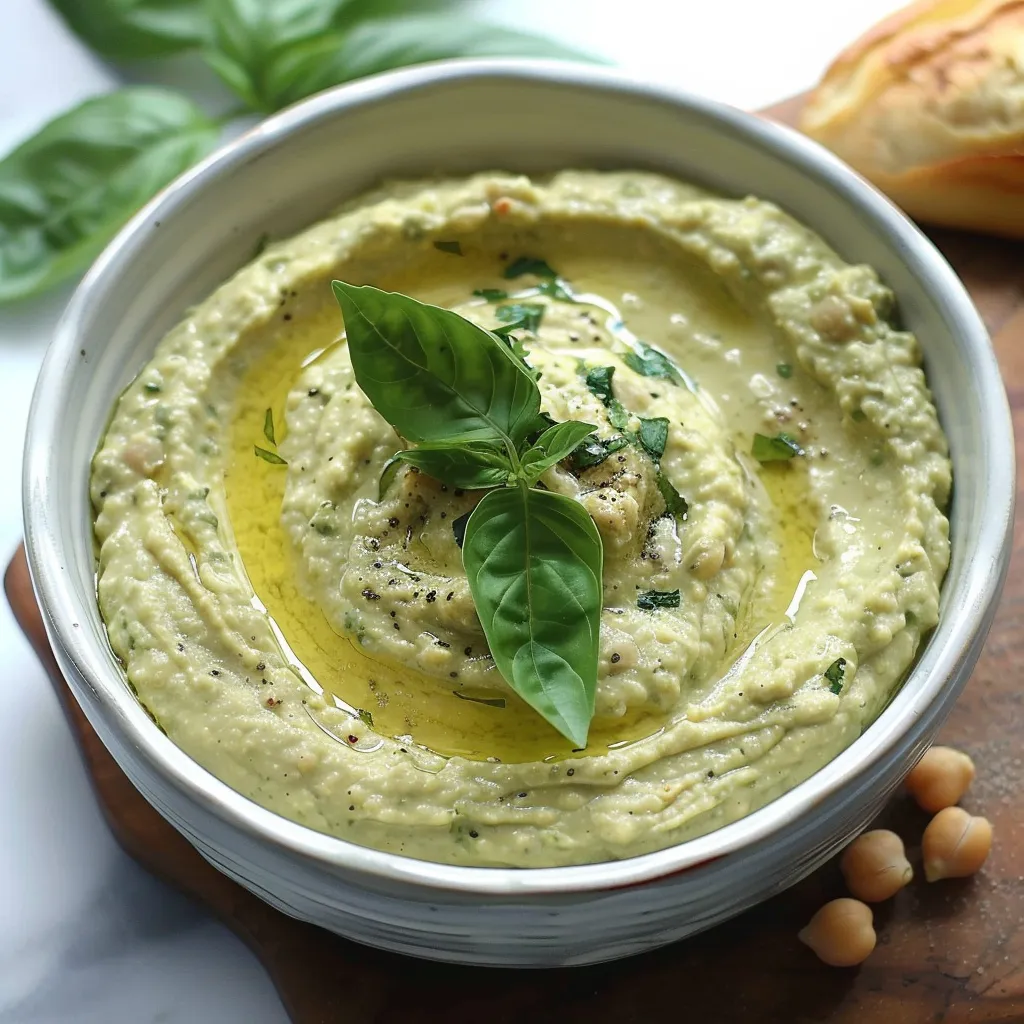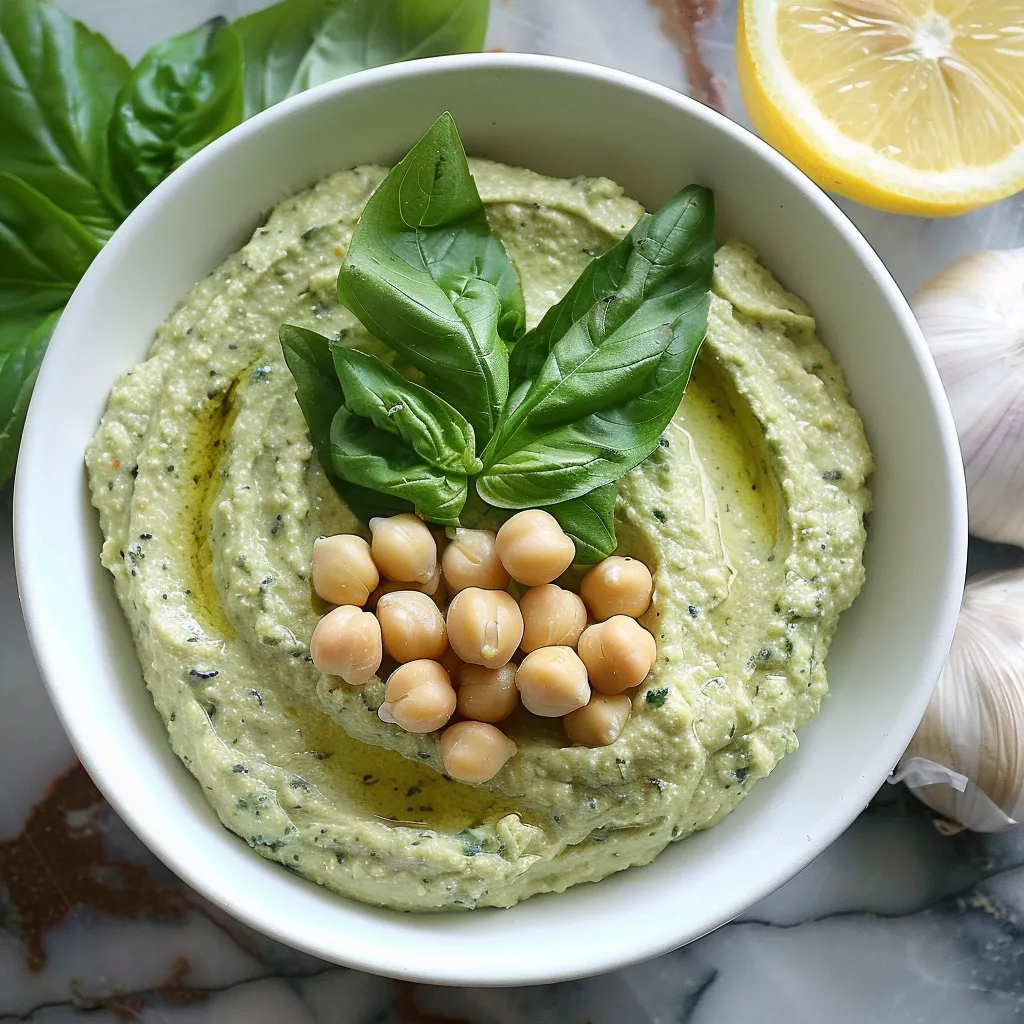 Pin it
Pin it
This silky lemon basil hummus transforms simple ingredients into a vibrant, fragrant dip that brightens any appetizer spread. The combination of fresh basil and zesty lemon creates a Mediterranean-inspired twist on classic hummus that's both refreshing and satisfying.
I first created this hummus when my basil plant exploded in the summer garden. My friends now specifically request this version whenever I host gatherings, often asking for the recipe before they leave.
Ingredients
- Chickpeas: Provides the creamy base and protein. Look for no-salt-added varieties for better flavor control.
- Fresh basil leaves: The star ingredient that adds vibrant color and aromatic freshness. Use young tender leaves for best flavor.
- Tahini: Creates that authentic hummus texture. Choose a high-quality brand that's well-stirred for the smoothest result.
- Olive oil: Adds richness and helps blend. Extra virgin provides the best flavor.
- Lemon juice: Brightens everything with essential acidity. Fresh-squeezed makes a noticeable difference.
- Garlic cloves: Adds depth and complexity. Look for firm bulbs with no sprouting.
- Salt: Enhances all flavors. Sea salt or kosher salt works beautifully.
- Water: Helps achieve the perfect consistency without adding extra fat.
Step-by-Step Instructions
- Prepare the chickpeas:
- Thoroughly rinse canned chickpeas under cold water until the water runs clear. This removes excess starch and sodium, resulting in a cleaner-tasting hummus. Drain completely to prevent watery hummus.
- Layer ingredients strategically:
- Add ingredients to your blender or food processor in the proper order. Place chickpeas, tahini, olive oil, and lemon juice closest to the blade. Position the basil leaves on top, furthest from the blade. This layering helps the blender work efficiently without needing to stop and scrape down the sides as frequently.
- Begin blending:
- Start with short pulses or a low speed setting. This initial gentle blending helps break down the chickpeas before incorporating the delicate basil. Pulse about 5-6 times to begin the breakdown process.
- Add water gradually:
- While the blender is running or between pulses, slowly drizzle in the water. Adding it gradually rather than all at once allows you to control the consistency perfectly. You might not need all the water depending on how thick you prefer your hummus.
- Blend to perfection:
- Continue blending until the mixture becomes completely smooth and creamy. This typically takes 1-2 minutes of continuous blending. The hummus should be spreadable but thick enough to hold its shape when scooped.
- Serve thoughtfully:
- Transfer to a serving bowl, creating a small well in the center. Drizzle with additional olive oil and garnish with fresh basil leaves and lemon zest for a beautiful presentation.
 Pin it
Pin it
The first time I served this at a family gathering, my aunt who claims to hate hummus had three servings before asking what this "amazing green dip" was. The fresh basil completely transforms traditional hummus into something special that even skeptics enjoy.
Storage Recommendations
This lemon basil hummus keeps beautifully in the refrigerator for up to 5 days when stored in an airtight container. The top might darken slightly due to the basil, but stirring will restore its vibrant color. For the freshest flavor, I recommend bringing it to room temperature for about 15 minutes before serving, which allows the olive oil to soften and the flavors to fully bloom.
Creative Serving Ideas
Move beyond pita chips and create a stunning appetizer board with this vibrant hummus as the centerpiece. Surround it with fresh vegetable crudités like cucumber spears, multicolored bell pepper strips, and sugar snap peas that complement the fresh herbal notes. Spread it on toasted sourdough topped with sliced cherry tomatoes for a quick lunch, or use as a flavorful sandwich spread instead of mayonnaise. My personal favorite is dolloping it over grilled vegetables for an instant elevation.
Smart Substitutions
If basil isn't available, substitute fresh spinach leaves with a smaller amount of dried basil for a milder version. Swap tahini with unsweetened almond butter or sunflower seed butter for a different nutty profile if you have sesame allergies. Meyer lemons create an exceptionally fragrant version when in season. For those who prefer less garlic intensity, roast the garlic cloves before adding them for a sweeter, more mellow flavor profile that still provides depth.
 Pin it
Pin it
A simple green dip can become an elegant centerpiece or vibrant lunch staple. It's perfect for every occasion.
Frequently Asked Questions
- → Can I use dried basil instead of fresh?
Fresh basil is recommended for the best flavor, but you can use dried basil in smaller amounts if necessary.
- → How can I make this dip smooth?
Blend thoroughly and slowly add water while processing to achieve a silky, spreadable consistency.
- → What can I pair with Lemon Basil Hummus?
It pairs wonderfully with pita bread, fresh vegetables, crackers, or used as a spread in sandwiches and wraps.
- → How should I store leftover hummus?
Store it in an airtight container in the refrigerator for up to 5 days for maximum freshness.
- → Can I use another type of oil?
Yes, avocado oil or another neutral oil can replace olive oil if needed, though olive oil adds traditional flavor.
- → Is this hummus dairy-free?
Yes, it's naturally dairy-free, making it ideal for vegan and plant-based diets.
